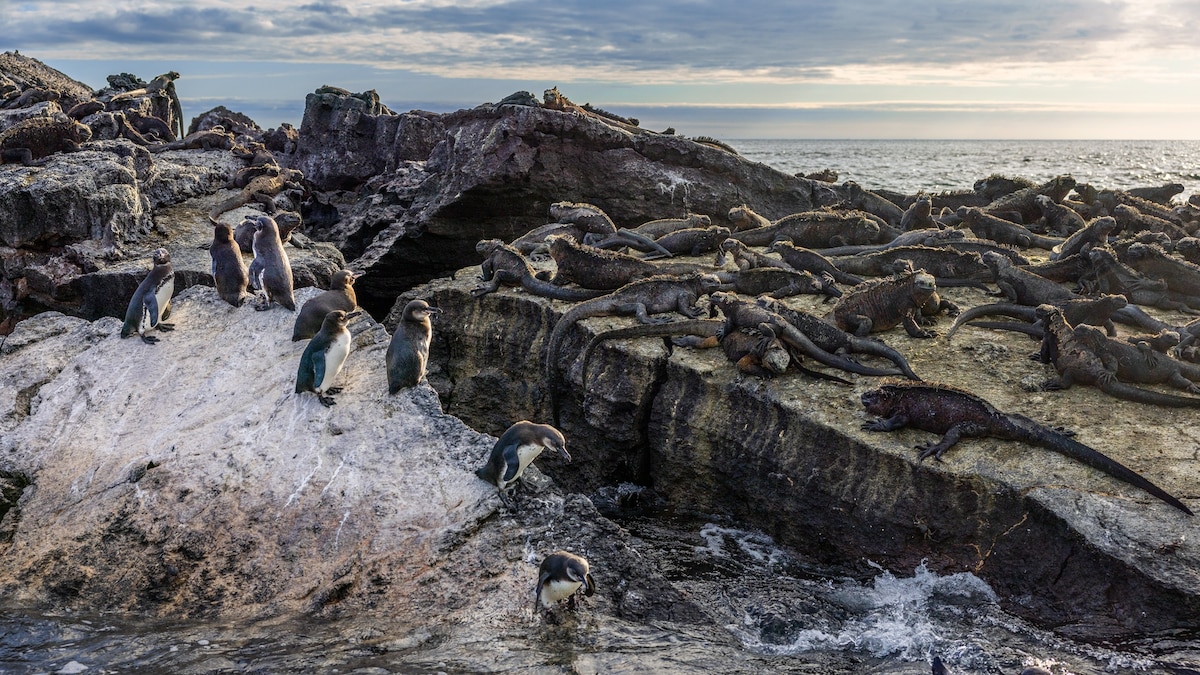Now Reading: The world’s rarest penguins don’t avoid heat—they embrace it
-
01
The world’s rarest penguins don’t avoid heat—they embrace it
The world’s rarest penguins don’t avoid heat—they embrace it

Roughly 600 miles off the coast of mainland Ecuador, conservation biologist Dee Boersma cruised in an inflatable Zodiac through the blue waters surrounding Bartolomé Island, a small part of the Pacific Ocean archipelago known as the Galápagos Islands. She was joined by several other scientists, all of whom scanned the shoreline for an elusive black-and-white seabird. Standing about a foot and a half tall, Galápagos penguins are the rarest and among the smallest penguins in the world. But most notably, they are the only ones living at the Equator, existing on these volcanic islands in the blazing hot sun.
“How could you not fall in love with these birds?” asked the 78-year-old director of the University of Washington’s Center for Ecosystem Sentinels and a National Geographic Explorer. “They’re comical, they’re curious, they’re endearing.”
Boersma suddenly pointed to five penguins near a cave. Then another, and another. Seven in total. Once the boat got close enough to shore, two Ecuadorians, veterinarian M. Gavilanes Escobar and park guard Marlon Ramón, leaped out, easily scaling the sharp and slippery rocks. In less than five minutes, Escobar was back, lightly gripping a penguin under its chin with one hand and propping its feet in his other. He passed it to Boersma, who was ready with her calipers to ascertain the size of the bird’s bill and feet. Then she pulled out her yellow tape measure to discern the length of the bird’s wingspan. “We’re measuring him for a suit,” she joked.
(The Galapagos penguin, one of the world’s rarest, sees a glimmer of hope.)
Fifty-four years ago, when I started this, I thought Galapagos penguins would be gone by now. But they’re still here.
These were the first steps in the process of recording information that allows researchers to monitor the health of the colony in this area. Next, Boersma cinched a red cord around the penguin’s chest and attached it to a scale. Now the flightless bird was dangling in midair, flippers whirling. “That’s a big one,” she told her colleague Caroline Cappello, a wildlife ecologist who has studied penguins in the Galápagos alongside Boersma for more than a decade. Cappello recorded the data: a little more than five pounds and likely a male. Freeing the feisty bird from the cord, Boersma then secured its head between her left forearm and knee in a well-practiced maneuver to protect her legs from painful bites. “You’re all right. You’re all right,” she told the squirming penguin. “You’re so soft. Yes, you are. Calm down. We’re going to let you go in just a minute.”

Conservation biologist and National Geographic Explorer Dee Boersma (at left) has spent 50 years studying Galápagos penguins and their changing habitats; for the past decade, she’s been mentoring wildlife ecologist Caroline Cappello to ensure the research will continue on the archipelago.
PHOTOGRAPH BY RENE EBERSOLE
The penguin’s flippers, thick at the top and tapered to a thin trailing edge, ideally shaped for soaring through water, were in great condition, she noted, smoothing them with her hands protected by beige wool fingerless gloves. She affixed a tiny metal tag into the webbing of its left foot and gently set it down on the edge of the Zodiac. Seemingly unfazed by the ordeal, the penguin surveyed the water, then leaned forward and quietly plopped into the Pacific to again swim among green sea turtles and marine iguanas. “Touching a bird like that is electric,” Boersma said as she watched it vanish beneath the surface.
It is also an increasingly rare opportunity for researchers. Today Galápagos penguins join the more than half of all penguin species that are classified as endangered or vulnerable, imperiled by such threats as warming temperatures, overfishing, habitat destruction, and pollution. Boersma, who has been called the Jane Goodall of penguins, considers these birds to be marine sentinels—or canaries in a coal mine—describing how one species’ rapid decline signals a significant natural or human-made change happening within its environment.
Still, she believes that the species has the capacity to hang on, in part because researchers continue to gain a better understanding of how these creatures leverage centuries of adaptations to be resilient in the increasingly unpredictable world around them. “Fifty-four years ago, when I started this, I thought Galápagos penguins would be gone by now,” she said. “But they’re still here.”

Galápagos penguins hunt by diving below schools of fish to drive their prey to the surface—sometimes into the mouths of opportunistic brown pelicans.
PHOTOGRAPH BY BLICKWINKEL/GOETHEL, ALAMY STOCK PHOTO
The Galápagos penguins’ evolutionary journey illustrates how environmental pressures shape species over millions of years. Genetic studies suggest they descended from Humboldt penguins roughly two million years ago during the Pleistocene epoch, a period marked by wide-ranging climatic changes. The earliest Galápagos penguin ancestors probably came to the islands by surfing the northbound Humboldt Current that brings cold, nutrient-rich water along the coast of South America. Likely settling on the western part of the archipelago, on Isabela and Fernandina Islands, the penguins found plentiful food and shelter. While the Humboldt and another current, the Cromwell, still flow here, they now bring nutrients and food intermittently in duration and intensity.
One of the significant factors to how Galápagos penguins adapted to living in this warm climate is that they nest in cool, shady crevices on the islands. The coastlines are sculpted by explosive volcanic eruptions and erosion, providing cracks and lava tunnels where penguins can avoid overheating. Their small stature allows them to squeeze into these dark places where they and their chicks hide from predators such as Galápagos snakes and Sally Lightfoot crabs.
With a thinner layer of fat and fewer feathers than most other penguins, these birds evolved for life in the subtropics. Galápagos penguins, along with the Humboldt, Magellanic, and African species, belong to a group known as banded penguins for the distinctive black-and-white patterning around their chests and heads. They all live in warmer climates and regulate their body temperature by panting, similar to a dog on a hot day, and they stand with their flippers outstretched to release heat. White feathers on Galápagos penguins’ faces and their featherless ankles and feet further help shunt warmth from their stout little bodies. The birds can also shed feathers around their faces during hot periods.
But the adaptation that sets Galápagos penguins apart is their flexibility as to when they molt (replace feathers) and breed, rather than having one fixed molting and mating season as other penguin species do. The timing is based on whether enough nutrients are being delivered from cool ocean currents and upwellings to give them energy to replace their feathers, which, unlike other penguins’ cycles, occurs before breeding and up to twice a year. They can delay molting and mating until food is available and there’s a better chance of successfully starting a family.
All this adds up to a boom-or-bust way of life. By tracking and measuring Galápagos penguins’ weight and population numbers over decades, Boersma made the incredible discovery that their breeding is tightly in sync with the rhythms of El Niños and La Niñas. The birds thrive during La Niña conditions, when there are strong currents of cold, nutrient-rich water flowing north, providing plentiful fish, squid, and crustaceans for the penguins. When El Niño’s warm water in the central and eastern Pacific displaces the cool currents, it drastically reduces upwelling and their food supply. In years when provisions are scarce, some penguins starve and breeding comes to a standstill. It can take decades for the population to recover. During a severe El Niño in the early 1980s, the population fell by more than half.
Now, as global temperatures heat up, El Niños are becoming more frequent and extreme, threatening to further reduce the availability of nutrients, while rising sea levels are inundating nesting sites. Still, Boersma has come to believe that even with the increasing frequency of El Niños and extreme weather events, some Galápagos penguins will persist because their ecosystem is also supported by periodic deepwater upwellings bringing pulses of nutrients to sustain the food chain. “But if for some reason the currents change and productivity goes down,” she said, “they’ll have trouble because there will be nowhere left for them to go but Peru or Chile—and that’s a long swim.”
Boersma estimates there are maybe 2,000 Galápagos penguins left, less than half as many as there were 50 years ago when she started her trailblazing research. But she believes that a couple of crucial actions can protect their future.
In order to survive and thrive, Galápagos penguins need humans to help them overcome two major threats: introduced predators, mainly rats and cats, and natural nesting areas becoming increasingly inhospitable.
Solving the first issue is fairly straightforward. Cats and rats arrived in the Galápagos nearly 200 years ago with sailors and whalers. They can easily scale difficult terrain and squeeze into nests of penguins and other seabirds, devouring eggs and chicks. Recently, the Galápagos National Park partnered with environmental organization Jocotoco to undertake an invasive species eradication program on Floreana Island, in the southern part of the archipelago. In October 2023, park managers began exterminating the rats and cats on Floreana, using traps and unmanned ultralight helicopters to disperse pellets of rodenticide and toxin-laced sausages across the entire island. The program appears to be working. Previously, a small number of penguins remained in the area, Boersma said, “but not easily.” Removing the predators and continuing to monitor for their presence will give “penguins a fair shot at long-term survival.”
You May Also Like
To mitigate the second threat, Boersma and her colleagues are hoping to obtain funding to build artificial nests and help the birds recolonize Floreana. Boersma first began thinking about constructing nests some years ago when she was puzzled by a penguin pair nesting on top of lava along the western edge of the archipelago on Fernandina Island, without any shade. The birds took turns sitting on the eggs from early evening until morning, but then retreated during the heat of the day, leaving the eggs unprotected. Eventually, the eggs died. Boersma realized that there weren’t enough shaded nest sites to go around, and that might be limiting how many baby penguins could join the population each year.
Fifteen years ago, she began experimenting with artificial-nest designs that would blend into the environment so they wouldn’t mar the islands’ natural beauty. “The park didn’t want doggy igloos or something like what they use at zoos,” she said. One option was an inconspicuous little penguin carport made from stacked lava rocks. The other—the one the penguins wound up preferring—was created by digging cavernous holes directly into the hard lava substrate. As in all real estate, location was key: The nests needed to be close to the water but not so close that they’d flood within the penguins’ three-month nesting period. “The idea of building nests,” Boersma said, “is that if conditions are good, you want everybody that wants to breed to be able to breed.”
On the third day of the expedition, Boersma and her team arrived at Punta Espinoza on Fernandina Island, the first place Boersma had ever tried to build the artificial nests. They disembarked from the Zodiac and walked carefully across the sharp lava slathered with iguana poop. Two members located and checked the nest sites: Cappello, 35, who is currently doing postdoctoral research at Cornell University, and Aura Banda Cruz, 42, a third-generation resident of the Galápagos and a naturalist working aboard the Silversea cruise ship that hosted Boersma’s survey while ferrying tourists around the Galápagos.
Peering into a small space between a pile of rocks, Cappello shouted that she’d found an artificial nest that appeared to have been used recently. There were shards of broken eggshells and downy feathers scattered around the area. “Maybe it hatched, or maybe it was predated,” Cappello said as she slipped the eggshells into a coin envelope for closer inspection later. Regardless, any sign of nesting activity was good news.
In her work as a cruise ship naturalist, Banda Cruz has spent nearly a decade photographing Galápagos penguins. That has led her to develop a noninvasive method to identify individuals, using the distinctive patterns of spots on their chests. “I realized that the spots were different on each one of them,” she said. “Each one is unique, like a fingerprint.” Similarly, researchers have learned to identify jaguars, zebras, dolphins, and even koalas by their distinguishing patterns.
Banda Cruz is hopeful that going forward, in the periods between annual surveys like this one, she can partner with other expedition naturalists who will send more photographs, helping create a visual archive that can be used to discern penguins when they’re sighted. The images can also provide records of the birds’ overall health and the ratio of adults to juveniles. “You can tell the adults because they have a white line around their cheek and their feet are black,” Banda Cruz said. “Juveniles have paler feet and white cheeks.”
I realized that the spots were different on each one of them. Each one is unique, like a fingerprint.
Aura Banda Cruz, naturalist
What’s more, the photos help document periods in which the penguins are working harder for their food, often correlating with an El Niño. “They start spending more time in the water,” Banda Cruz said. “They don’t have time to dry completely and they start growing algae, so when you see a green penguin, it’s a symbol that things are not going well for them.”
For her part, Boersma is thrilled to still be learning new things about the lives of Galápagos penguins, especially from this next generation of scientists. For a long time she worried that she wouldn’t have anyone to take over her Galápagos research when she retired. “You realize when you’re jumping and crawling around on the lava that your days are numbered—you can’t do this forever,” she said, sitting on the edge of the Zodiac while her colleagues checked another area for penguins and signs of nesting. “That’s why I was so happy to find first Caroline and now Aura. I think they can make a dynamic team and carry it on for another 10, 20, 30 years if they want.”
She went quiet, watching a male penguin standing alone along the shore, basking in the late afternoon’s golden light. Awwwwww, awwwwwww, the penguin brayed, trying to attract a mate. “Awwwwww, awwwwwww,” Boersma called back. “He’s saying, ‘Come see my etchings. I’ve got a good nest. Come take a look,’ ” she said, grinning.
If the conditions stayed as favorable as they’d been in recent weeks—cold water and lots of fish—she felt confident: “He’ll be breeding soon.”
“Secrets of the Penguins” premieres April 20 on National Geographic and streams the next day on Disney+ and Hulu.
A version of this story appears in the May 2025 issue of National Geographic magazine.
Writer Rene Ebersole traveled to the Galápagos Islands for this story. On her last assignment for the magazine, she tracked whooping cranes from Canada to Texas.






















